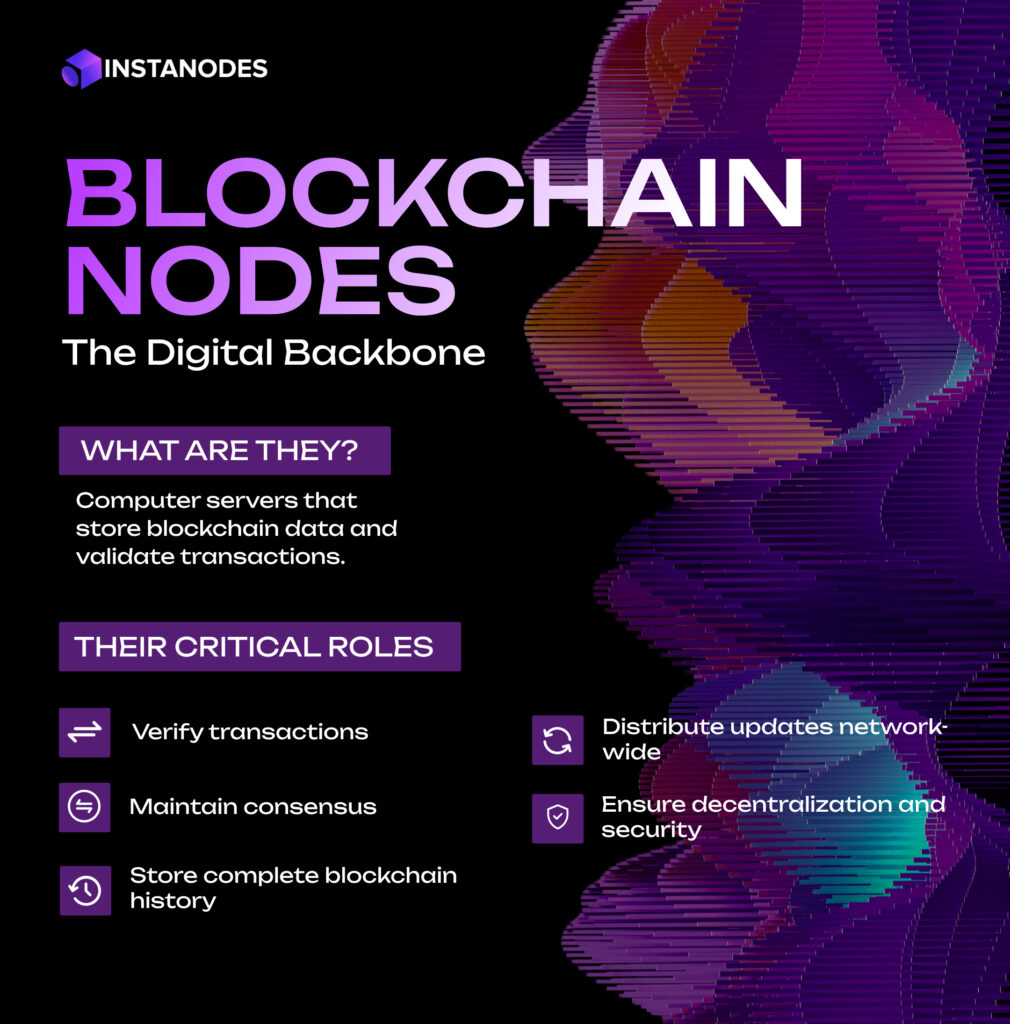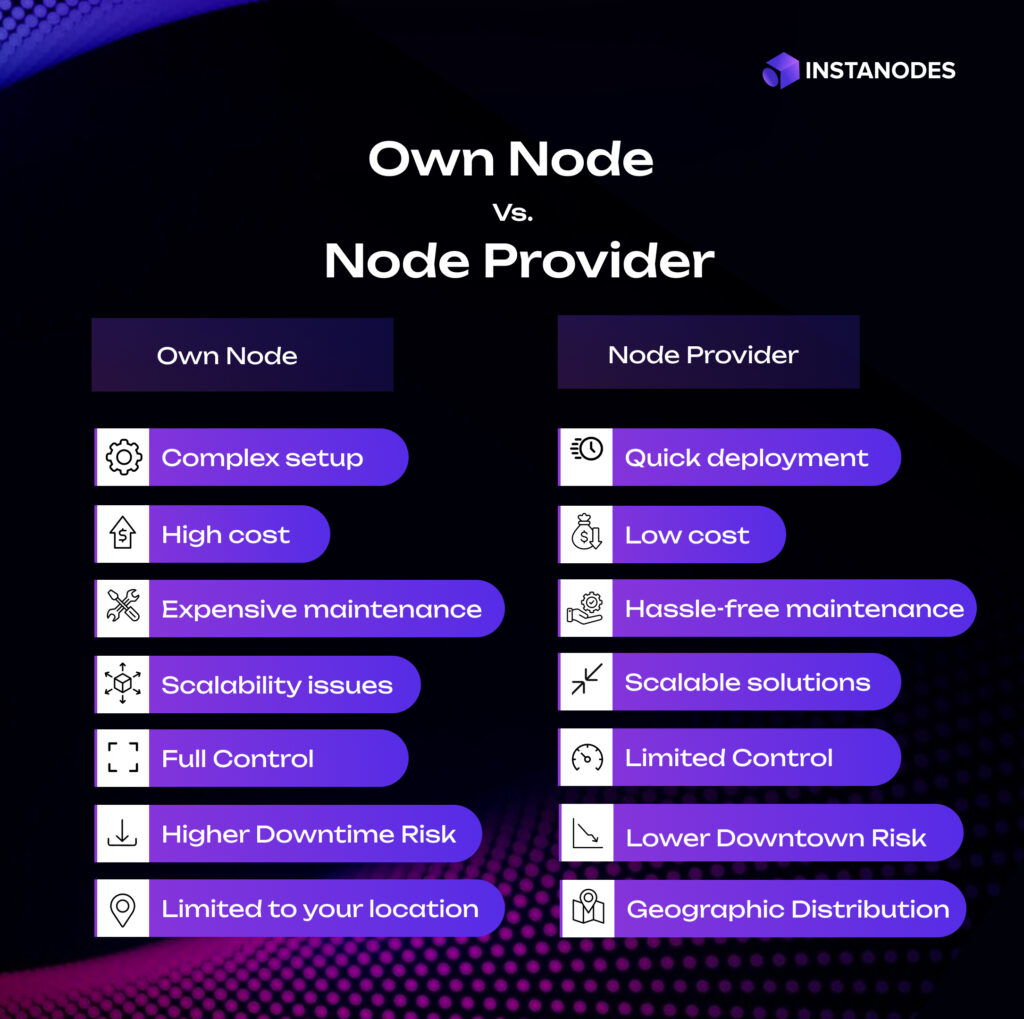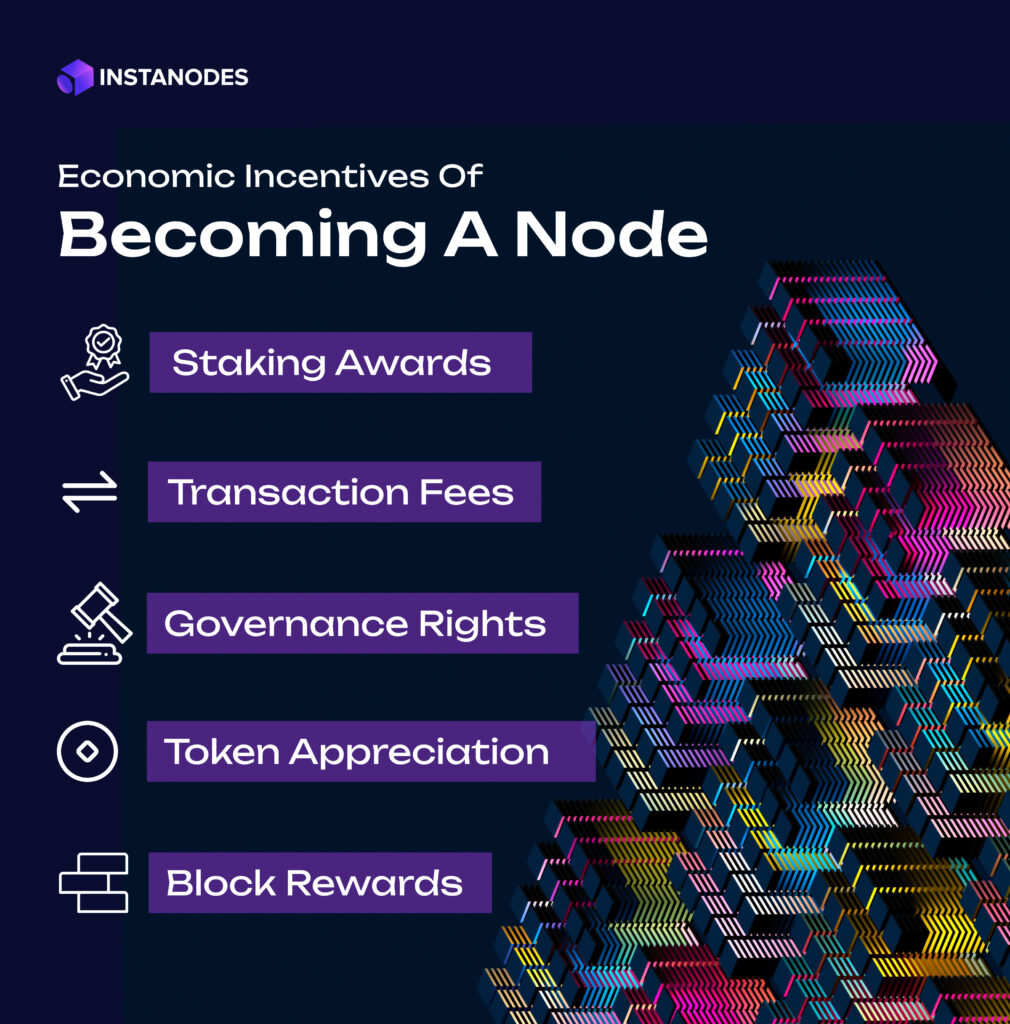Ready to build a decentralized infrastructure? First, you need to understand the role of a blockchain node in ensuring smooth functioning of the blockchain network. Nodes in blockchain are the components of the network used in verifying and sending transactions, storing agreements, and holding a duplicate of the ledger. Together, their role is crucial to preserving the security and openness of the blockchain network.
Those who have just begun to navigate the world of decentralized infrastructure, need to have a clear understanding about different types of nodes, including full nodes, light nodes, and mining nodes, each of which plays a unique role in the network. However, despite becoming acquainted with the functions of blockchain nodes, it will be tough to handle the intricacies of node setup, so it will be better to leverage the expertise of the best blockchain node provider to build decentralized systems. Experienced blockchain infrastructure providers help make the best use of the revolutionary potential of blockchain technology in transforming sectors that have historically depended on centralized models.
What Are Blockchain Nodes? Decoding the Backbone of Decentralized Networks

Blockchain nodes represent the essential components of decentralized networks, functioning as vital digital infrastructure that supports the operation of the entire blockchain ecosystem. They can be envisioned as specialized computers or servers collaborating to form a global, distributed ledger system, with each node maintaining a complete or partial record of the blockchain’s transaction history.
These digital sentinels perform multiple essential functions:
- Storing complete or partial blockchain transaction records
- Validating and verifying new transactions
- Communicating with other nodes to maintain network consensus
- Ensuring network security and integrity
- Propagating transactions and spreading information across the network
Unlike traditional centralized systems where a single server controls all data, blockchain nodes distribute this responsibility across multiple independent participants.
This decentralized approach ensures:
- No single point of failure
- Enhanced network resilience
- Transparent and tamper-resistant record-keeping
- Democratic governance of the network
Each of the nodes in blockchain behaves as a guardian, validating and verifying transactions individually. When a transaction is initiated, nodes collectively verify its authenticity, establishing a trustless environment in which there is no need for a central authority to authenticate transactions.
By keeping various copies of the blockchain distributed among geographically disparate locations and computer systems, nodes establish an immutable, open, and very secure digital infrastructure that supports cryptocurrencies, smart contracts, and decentralized applications.
The security of blockchain nodes is most important for data integrity and trust. Hacked nodes can result in data tampering, network interference, and monetary losses. Currently, organizations are largely relying on Blockchain Infrastructure as a Service and Blockchain Node as a Service, as they have rich expertise in the setup and maintenance of blockchain nodes. Blockchain node providers help secure nodes against attacks by ensuring access controls and performing periodic security audits that are essential for a secure and trustworthy blockchain environment.
Types of Nodes: Full, Light, and Archival – Understanding Their Unique Roles
| Feature | Full Node | Light Node | Archival Node |
| Function | Stores entire blockchain, validates transactions | Stores only block headers, relies on full nodes | Stores full blockchain history, including all states |
| Storage Requirements | Medium (1TB+) | Low (1GB-5GB) | Very High (10 TB+) |
| Hardware Needs | Moderate CPU/RAM | Minimal | High-end CPU/RAM |
| Security | High | Moderate | Very High |
| Network Role | Verifies transactions, enhances decentralization | Fast access to blockchain data | Supports historical data, useful for explorers & research |
| Sync Time | Hours to days | Minutes | Days to weeks |
| Independence | Self-sufficient | Depends on full node | Self-sufficient |
| Use Case | Miners, validators, dApp developers | Mobile wallets, lightweight applications, IoT | Blockchain explorers, forensic analysis, auditing |
| Example | Bitcoin Core, Geth (Ethereum) | Metamask, Trust Wallet | Etherscan, Infura (archival mode) |
Blockchain networks rely on different types of nodes, each serving a unique purpose in maintaining the ecosystem’s efficiency, security, and accessibility. Understanding these node types is crucial for comprehending how decentralized networks operate.
Full Nodes: The Comprehensive Guardians
Full nodes are the most robust and comprehensive participants in a blockchain network. They:
- Download and store the entire blockchain history
- Validate every single transaction independently
- Enforce all blockchain protocol rules
- Maintain a complete and up-to-date copy of the ledger
- Contribute significantly to network security and decentralization
Nodes in blockchain demand heavy computational power, such as high-performance hardware, large storage (usually 1TB or higher), and a secure, high-bandwidth internet connection. They are responsible for safeguarding against malicious transactions and keeping the network stable.
Light Nodes: Efficient and Lightweight Participants
Light nodes represent a more resource-efficient alternative designed for devices with limited computational capabilities:
- Download only block headers, not the entire blockchain history
- Rely on full nodes for transaction verification
- Consume minimal storage and processing power
- Ideal for mobile devices, web browsers, and IoT applications
- Provide quick and lightweight blockchain interaction
While less secure than full nodes, light nodes enable broader participation in blockchain networks by reducing technical and hardware barriers.
Archival Nodes: Historical Record Keepers
Archival nodes are specialized full nodes that:
- Maintain a complete historical record of the blockchain
- Store all past transactions and network states
- Provide comprehensive historical data for research and analysis
- Support blockchain explorers and advanced analytics
- Serve as critical resources for developers and researchers
These nodes are valuable in recognizing long-term blockchain patterns, conducting thorough research, and having a complete historical overview of the development of the network.
Each node type plays its own role in the blockchain system, providing security, efficiency, and access in varying use cases and user needs.
How Nodes Validate Transactions: The Consensus Mechanism Explained
Transaction validation is the pulse of blockchain networks, guaranteeing the integrity and authenticity of each transaction. Different consensus mechanisms govern this process:
Proof of Work (PoW)
- Miners compete to solve complex mathematical puzzles
- First to solve the puzzle gets to add the next block
- Requires substantial computational power
- Used by Bitcoin and initially by Ethereum
Proof of Stake (PoS)
- Validators are selected to form new blocks depending on the amount of cryptocurrency they “stake”
- More energy-efficient compared to PoW
- Reduces computational requirements
- Adopted by Ethereum 2.0 and many modern blockchain networks
Delegated Proof of Stake (DPoS)
- Token holders vote for a limited number of delegate nodes
- Chosen delegates validate transactions and create blocks
- Increases scalability and reduces centralization risks
The Critical Role of Nodes in Maintaining Blockchain Security and Integrity
Blockchain nodes are the first line of defense guaranteeing the security, transparency, and reliability of the network. Their multi-faceted role in upholding blockchain integrity includes a number of important functions:
Transaction Verification
Nodes play a pivotal role in preventing fraudulent activities through rigorous transaction validation:
- Cross-checking transaction details
- Verifying digital signatures
- Ensuring sufficient account balances
- Detecting and rejecting unauthorized transactions
Preventing Double-Spending
A fundamental security mechanism where nodes:
- Track every transaction across the network
- Confirm each transaction’s uniqueness
- Immediately reject attempts to spend the same cryptocurrency multiple times
- Maintain a chronological and immutable transaction record
Consensus Mechanism Protection
Nodes collectively maintain network security through:
- Distributed agreement on transaction validity
- Rejecting malicious or incorrect transactions
- Requiring multiple node confirmations
- Creating a transparent, tamper-resistant environment
Network Resilience
By distributing network responsibilities:
- No single point of failure exists
- The network remains operational even if some nodes go offline
- Malicious actors cannot easily compromise the entire system
- A decentralized nature ensures robust protection
Transparency and Accountability
Nodes ensure:
- Every transaction is publicly verifiable
- Complete transaction history is maintained
- Instant traceability of all network activities
- Elimination of centralized manipulation risks
Node Infrastructure: Hardware, Software, and Network Requirements
Setting up a blockchain node requires robust infrastructure, including specialized hardware, optimized software, and stable network connectivity. It’s going to be a cumbersome and expensive endeavour for businesses having budget constraints, so they cannot ignore the significance of Node as a Service blockchain solution provider.
Hardware Specifications
Robust blockchain node infrastructure demands high-performance hardware:
Computational Requirements
- High-performance multi-core processor (minimum 8 cores)
- Intel/AMD processors preferred
- Recommended CPU clock speed: 3.0 GHz or higher
- ECC (Error-Correcting Code) RAM recommended
Memory and Storage
- Minimum 16GB RAM (32GB+ for optimal performance)
- Fast SSD storage with a minimum 2TB capacity
- NVMe SSD preferred for faster data processing
- RAID configuration for data redundancy
Network Hardware
- Dedicated server or high-performance workstation
- Stable network interface card (1 Gbps minimum)
- Uninterruptible Power Supply (UPS)
Software Requirements
Operating System
- Linux distributions preferred (Ubuntu, CentOS)
- Regular security updates
- Minimal background processes
Node Software
- Latest blockchain-specific node software
- Compatible wallet applications
- Security patches and updates
- Firewall configurations
Network Considerations
- Stable internet connection (minimum 10 Mbps)
- Low-latency network
- Dedicated IP address
- Open specific blockchain-related ports
- Consistent network uptime
Security Protocols
- VPN recommended
- Secure SSH access
- Regular security audits
- Encrypted communication channels
Running Your Own Node Vs Choosing Blockchain Infrastructure Provider
Having and running a blockchain node is a major task that necessitates technical know-how, high computational power, and around-the-clock monitoring. Companies and developers engage in endless discussions about whether to have their own node or use a blockchain infrastructure provider that delivers blockchain Node as a Service offerings.

Running Your Own Node
Running your own blockchain node grants you complete control over transactions, security, and governance participation. However, it comes with challenges:
- You can independently manage transactions, data security, and upgrades. However, it will burden you with high operational costs because running a node requires powerful hardware, constant internet connectivity, and storage space.
- It ensures enhanced privacy. Your transactions remain confidential without reliance on third-party providers. It’s not as easy as it sounds. Setting up and maintaining a node demands technical expertise in blockchain protocols.
- Besides this, you can have direct engagement in blockchain governance and decision-making. However, nodes require continuous updates and security patches to remain operational.
Choosing a Blockchain Infrastructure Provider
Most companies opt for blockchain Infrastructure as a Service providers, which provide pre-configured and managed nodes, obviating the hassle of node maintenance.
- It ensures hassle-free node deployment without any need of being troubled with technical glitches.
- Avoids the requirement of costly hardware and maintenance fees.
- Guarantees availability, scalability, and strong security features.
- You get personal technical support for troubleshooting and upgrades.
For developers and organizations that value efficiency and scalability, blockchain node providers offer a viable solution that reduces costs and technical hurdles while providing hassle-free blockchain integration.
Economic Incentives: Mining, Staking, and Running Your Own Blockchain Node
Operating a blockchain node can be profitable, with several incentive models motivating network involvement. These incentives are mining rewards, staking rewards, transaction fees, and governance participation.

Mining Rewards
Some blockchains like Bitcoin and Litecoin use Proof of Work (PoW) consensus mechanism. There is a competition between miners to solve complex cryptographic puzzles in order to add new blocks to the blockchain. The one who solves the problem before everyone else receives a block reward, which consists of newly minted cryptocurrency and transaction fees from validated transactions. One can earn huge profits for mining, but at the cost of setting up expensive hardware (ASIC miners) and consumption of significant amounts of electricity.
Staking Rewards
Blockchains using Proof of Stake (PoS) and Delegated Proof of Stake (DPoS) the process of selecting validators is based on the amount of cryptocurrency they stake as collateral. These validators earn rewards proportional to their staked assets and play a role in securing the network by validating transactions. Staking is more energy-efficient compared to mining since it does not involve costly hardware or power consumption.
Transaction Fees
Full nodes and validators typically receive a share of transaction fees that users pay for carrying out blockchain transactions. On high-traffic networks, such fees can represent a considerable income stream for node operators.
Governance and Decision-Making
Staking-based blockchains usually offer governance privileges to validators and node operators. With staking, participants can vote on network alterations, governance propositions, and protocol upgrades. This encourages node operators to work for the good of the network for long-term stability.
Block Rewards
Block rewards encourage node operators to validate and secure blockchain networks. Miners or validators are rewarded with new tokens and transaction fees for successfully adding blocks to the chain. Rewards taper off over time through halving events, resulting in scarcity while ensuring network security. This mechanism allows continued participation without the need for centralized control, making up the economic backbone of decentralized cryptocurrencies.
What Makes Instanodes the Best Blockchain Node Provider?
Instanodes stands out as the best blockchain node provider in the increasingly competitive space of blockchain infrastructure solutions. Here’s why businesses and developers consistently choose our services:
Unmatched Reliability
- 99.99% uptime guarantee with redundant systems across multiple geographic regions.
- Advanced monitoring systems preventing downtime before it occurs.
- Enterprise-grade hardware optimized specifically for blockchain operations.
Superior Technical Infrastructure
- Blockchain Infrastructure as a Service designed for seamless integration.
- Ultra-low latency connections.
- Support for 30+ blockchain networks including Ethereum, Solana, Polkadot, and Bitcoin (including non-EVM chains).
- Automatic scaling to handle traffic spikes without performance degradation.
Developer-Focused Experience
- Intuitive dashboard providing real-time analytics and performance metrics.
- Comprehensive API support.
- Flexible subscription options tailored to development lifecycle needs.
Enterprise-Ready Security
- Ready-to-deploy infrastructure.
- Multi-layer encryption for all data in transit and at rest.
- Regular security audits.
Cost-Effective Scalability
- Our Blockchain Node as a Service model eliminates capital expenditure.
- Pay-as-you-grow pricing that adapts to your actual usage.
- No hidden fees for bandwidth or API calls.
- Resource optimization algorithms reducing infrastructure costs by 30%+.
Expert Support
- 24/7 technical assistance from blockchain specialists.
- Average response time under 15 minutes.
- Personalized onboarding process for new clients.
- Regular technical webinars and knowledge base resources.
Instanodes delivers what others promise—enterprise-grade blockchain Infrastructure as a Service that lets you focus on building your applications, not maintaining your infrastructure.
Conclusion
Blockchain nodes form the core of decentralized networks, as they play a significant role in transaction validation, security, and integrity. Knowledge of various types of nodes—full, light, and archival—assists in choosing the appropriate infrastructure for blockchain activities. Consensus algorithms like Proof of Work and Proof of Stake provide secure transaction authentication, and node operators provide blockchain security through redundancy, censorship resistance, and data integrity.
Creating a node involves strong hardware, software, and networking infrastructure, which can prove difficult for individuals and organizations. Although operating a node confers advantages such as increased control and economic rewards via mining and staking, selecting a blockchain infrastructure provider streamlines the process and minimizes operational complexities.
As blockchain Node as a Service becomes more popular, companies can now easily deploy and handle nodes without the hassle of caring for infrastructure. You can contact blockchain infrastructure providers and forward your queries before handing over the responsibility of node setup and maintenance. However, it is noticeable that Instanodes is the best because of its exceptional support for non-EVM blockchains, high reliability, security, scalability, and affordable solutions. We ensure businesses have worry-free blockchain participation, without any need to gain technical expertise.
Choosing us will help you to experience the difference. Contact now!

